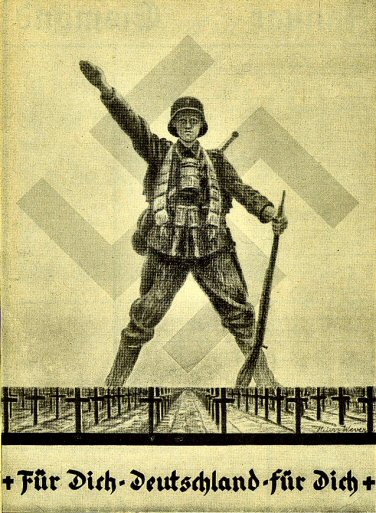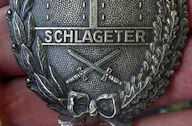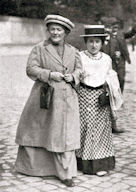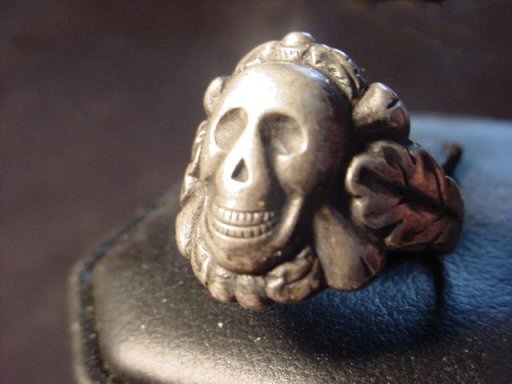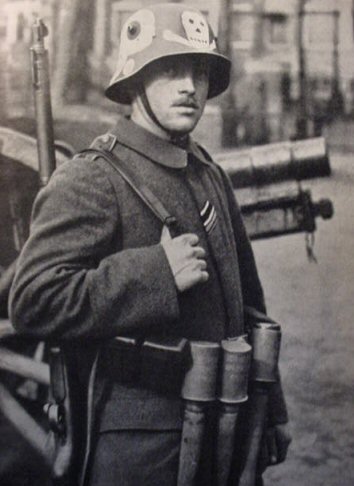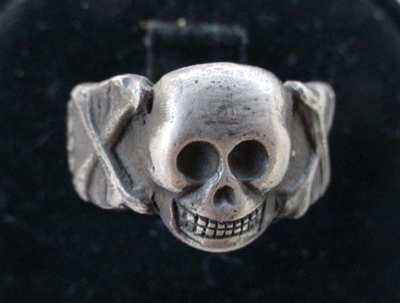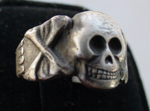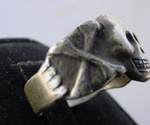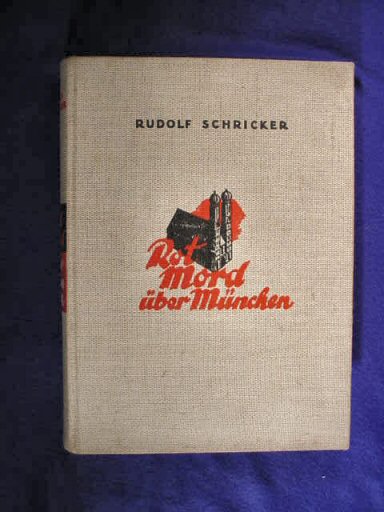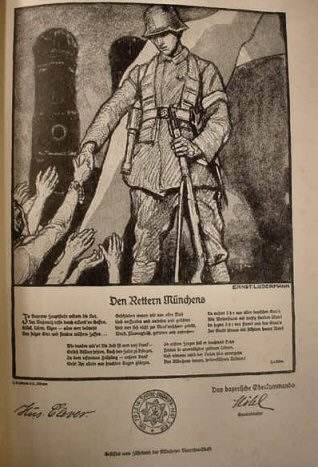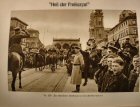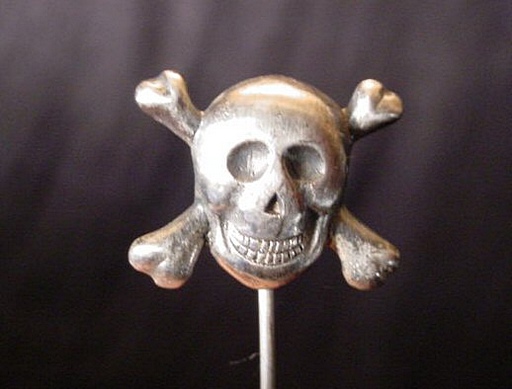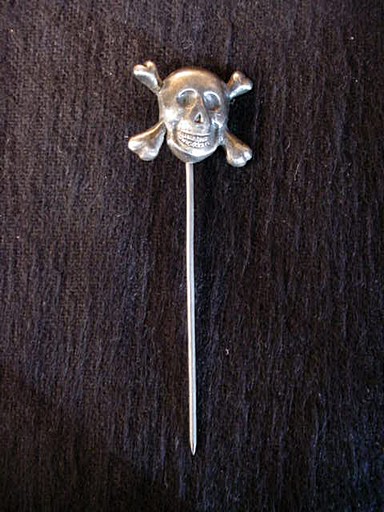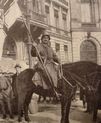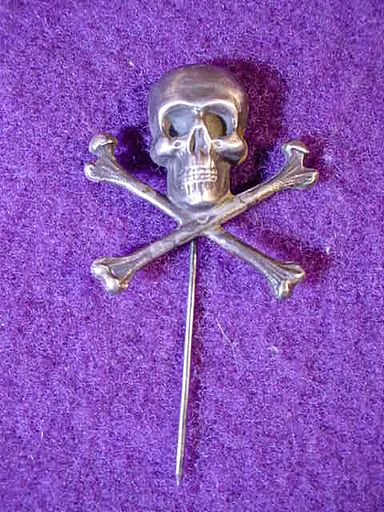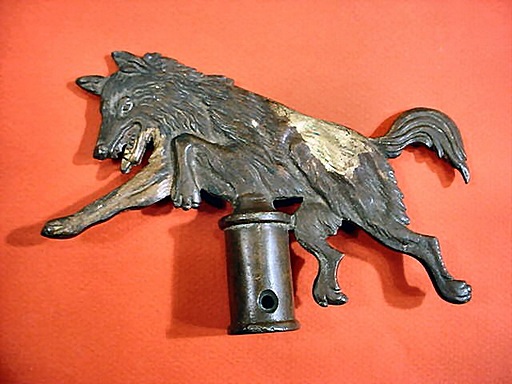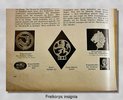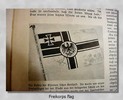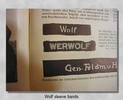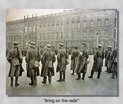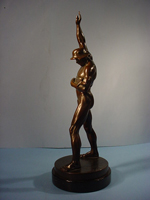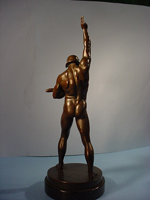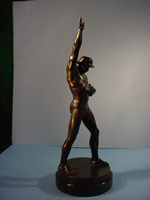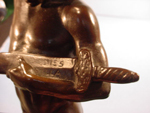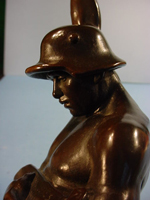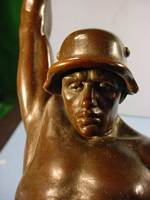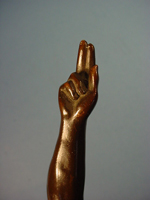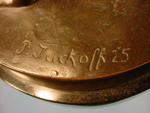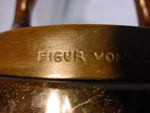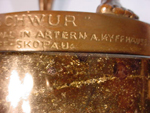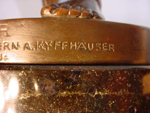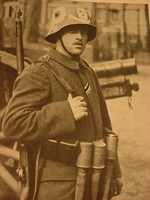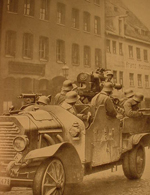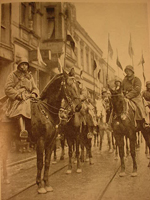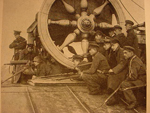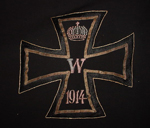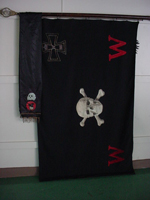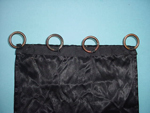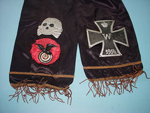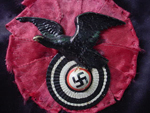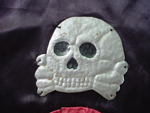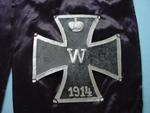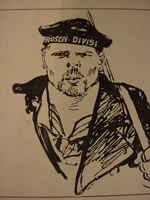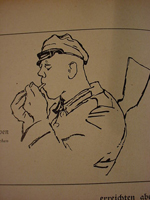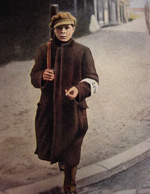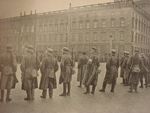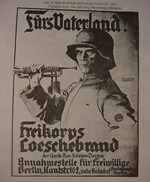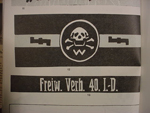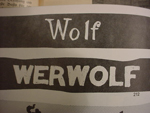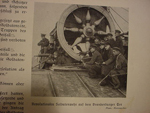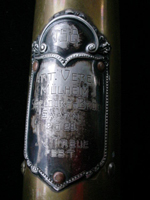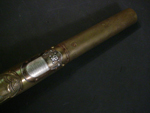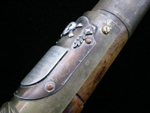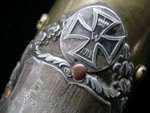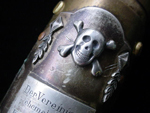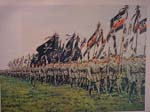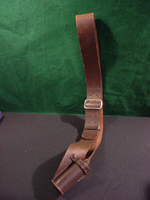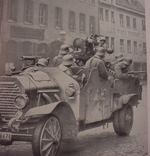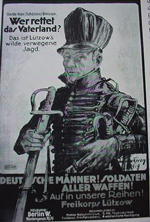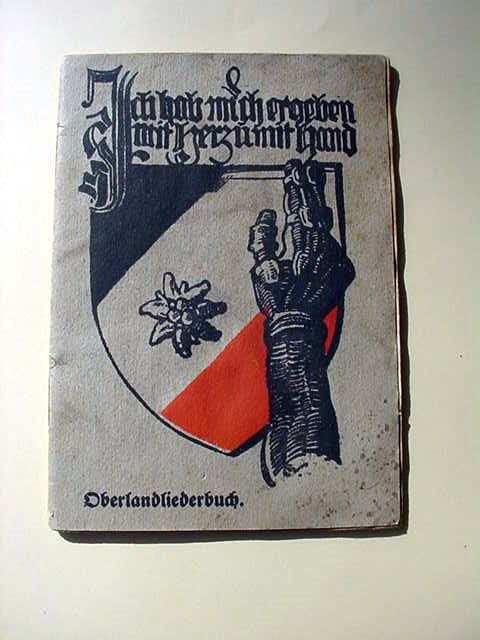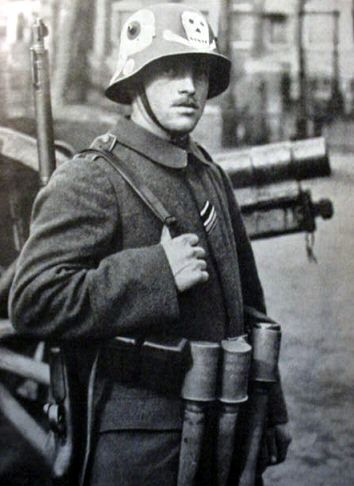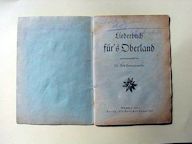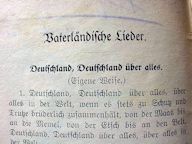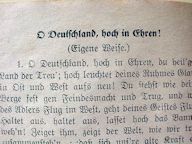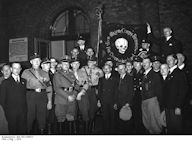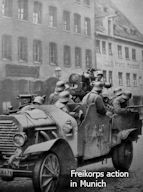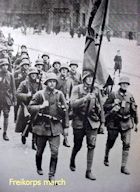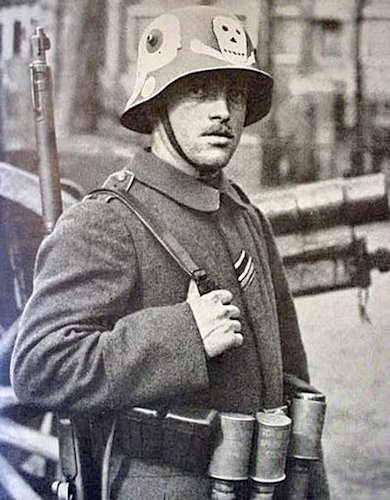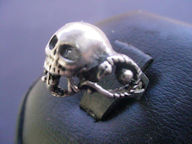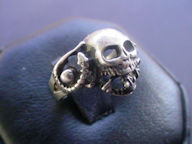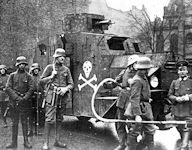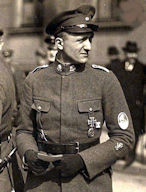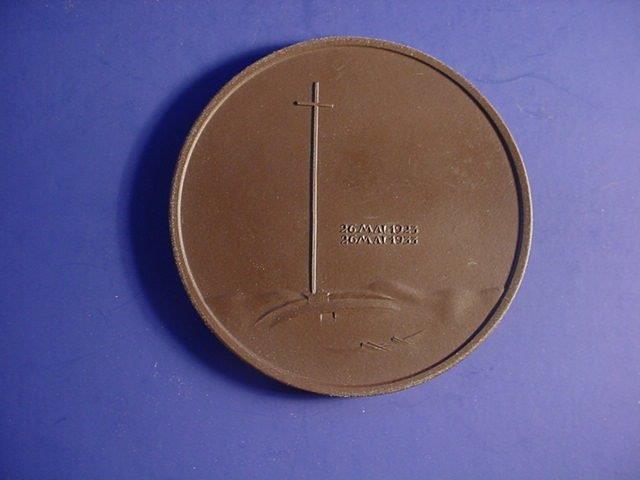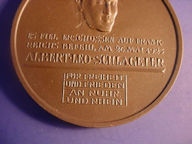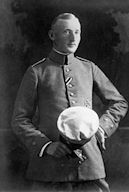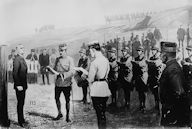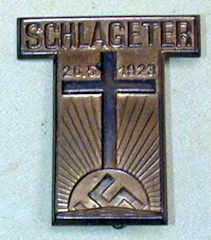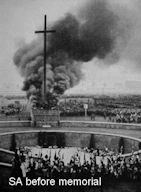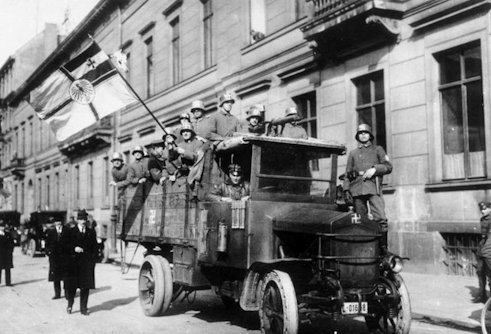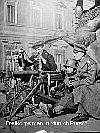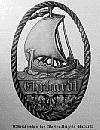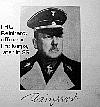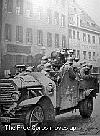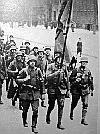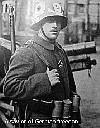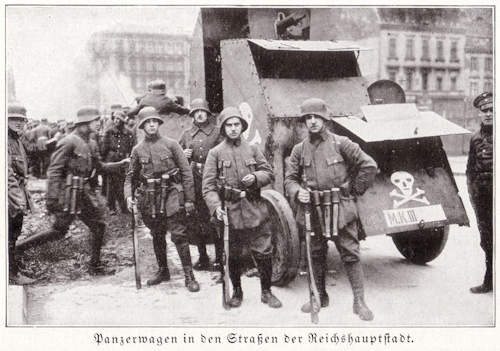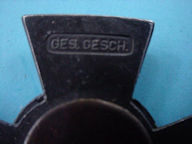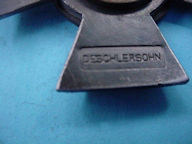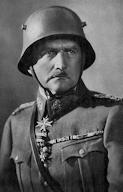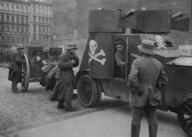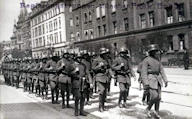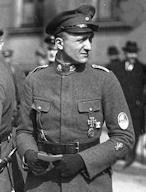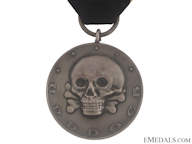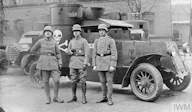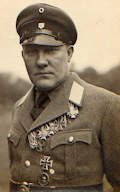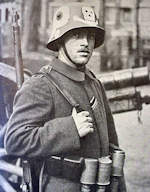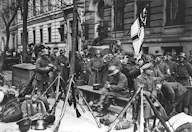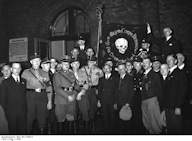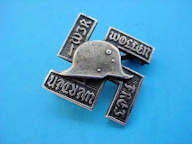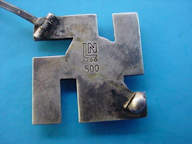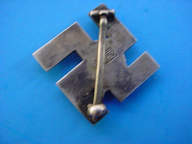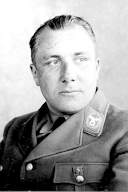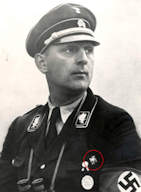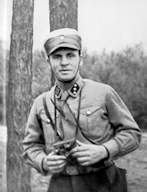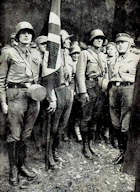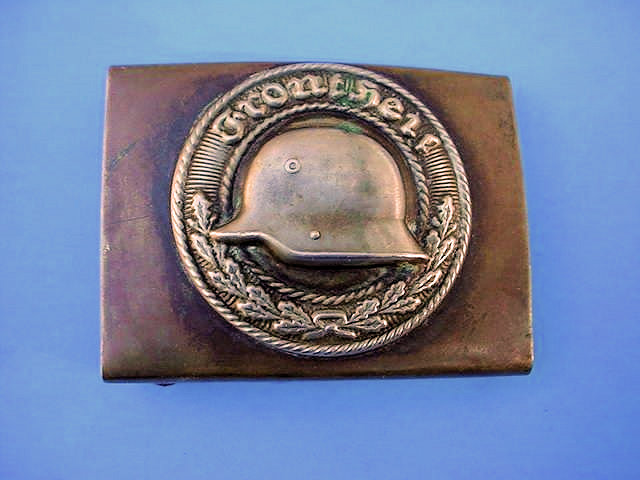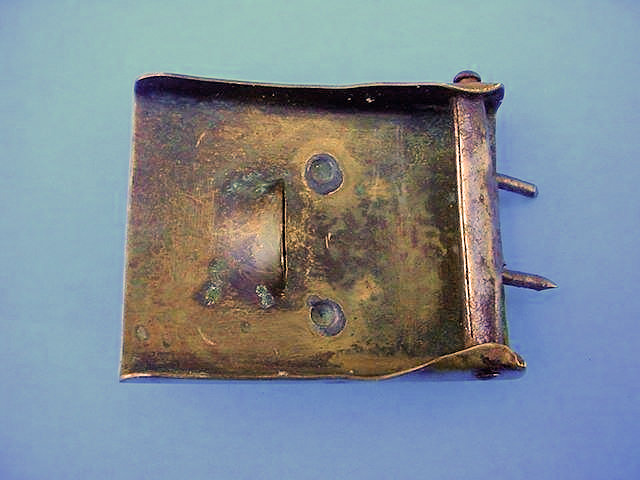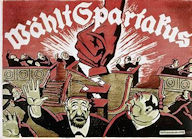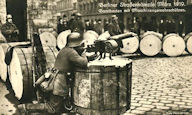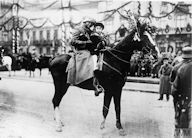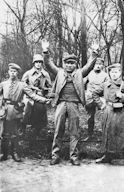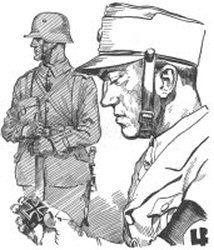|
|
|
|
Freikorps
Page 1
|
|
|
||||||||||||
|
Freikorps Ring (Leering Skull) (Item FREI 1-2; WEHR 18-20) |
||||||||||||
| DESCRIPTION: This is one of the favorite ring styles of the Freikorps troops who saved Germany from the red menace in the 1920s. The skull is very similar to the “Werewolf” faction of the Free Corps. But skulls were used by several of these fierce combat-ready troops. See Item WEHR 3-2. The Freikorps is credited with being the one element that saved Germany from inclusion in the monstrous Soviet system of horror. Forever must its memory be preserved. The ring is clearly marked with ‘835’ silver designation inside. This is a handsome rare addition to any Kampfzeit collection.
PRICE: $950.00 |
| ||||||
|
Freikorps or Sturmtruppen Ring (Item FREI 1-3; WWI 8-1) |
||||||
| DESCRIPTION: Here is one of the tradition rings produced in the 1920s.For the narrative of how we acquired these rings and other jewelry see About Our Rings. The leering skull was a symbol of the German elite divisions know as Sturmtruppen, Storm Troops (assault detachment), which were infantry units specially armed and trained for attacking enemy defensive positions. This type of ring was employed by both these special troops and the Freikorps, later. The Freikorps, Free Corps, was a paramilitary unit that fought the communists in the German streets of Berlin and Munich and in the post-WWI years. They were used to defend the German borders against the good possibility of invasion by the red army and later they were very successful and effective in putting down the revolution from the left-wing Spartacists and other human rodents in 1921. After saving Germany from the red menace the Freikorps was dissolved and many of these seasoned fighters joined the ranks of the SA (Sturmabteilung) (Storm Sections), the private army of Adolf Hitler and the NSDAP. This is a traditions ring made in commemoration of the mission of the Deutsches Freikorps. Of course, many of them were worn by ex-member and SA troopers. The ring is quite nice and made in the old 1920s fashion although produced in the mid to late 1930s. This is a very nice-looking skull ring.
PRICE: $550.00 |
|
|||||||||||||||||||
|
Book Rot Mord über München (Item FREI 1-4) |
|||||||||||||||||||
| DESCRIPTION: The book Red Murder over Munich comprises 226 pages that chronicle the attempted Bolshevik takeover of Germany in the 1920s after WWI. It stands as a printed memorial to the bravery and loyalty of the men of the Freekorps battalions who effectively stopped this red monolith in its bloody tracks. The book has the stamp of the NSDAP Kampfbund Ortsgruppe Grosshadern in its front cover. The many pictures are really wonderful, especially the one of the Munich citizen sleeping in the window of the Ring Hotel with a bullet hole still in it from the day before. We will not go deeply into the reasons for the Putsches and the reactions. The murders from the left; the revenge of the right; the Freikorps, the advent of the Hitler NS revolution; it’s all here for the German reader. The pictures are great and they spell it out for the non-German reader. The pictures are very realistic; look at the noble face of the Freikorps leader Ritter von Epp on page 21. Look at the twisted criminal countenances of the communist leaders on page 36. They say a picture is worth a thousand words. This book goes a long way to prove the point. It was a terrible time for Germany and it is fully documented here. It was a time of heroes; it was a time of murdering villains. It was the Kampfzeit for the rising NSDAP. It measures 7 x 9 inches and about 1 inch thick. It’s in excellent condition with fine, linen cover.
PRICE: SOLD |
|
||||||||||||||||||
|
Freikorps Stickpin (Item FREI 1-5; PINS 5-22a) |
||||||||||||||||||
| DESCRIPTION: Here is the stickpin for the Free Corps (Freebooters). Had it not been for these ex-soldiers for World War I the reds would have completely taken over Germany in the 1920s. They were sectioned off into the various districts of the fatherland and they fought bravely to save Germany from falling into the scourge of international communism. All sorts a WWI soldiers flocked to the several corps; the most famous being the Erhardt Brigade and the Freikorps von Epp Brigade. The most used badge of these brave veterans was a skull and cross bones. It was used in their helmets, insignia, vehicles, etc. Because of the vibrant patriot patriotism of these men it only followed that they would become the actual vanguard of the NSDAP and when the red menace was over, for the most part, these fighters swelled the ranks of the SA. Many of them who are officers later were admitted to the SS. This pin, when worn, commanded much respect, and the pride of the wearer was evidenced by the sheer size of it. The pin is more than a half-inch wide and long. The skull is marked ‘800’ on its back standing for silver content. This is a great-looking stickpin and is eminently important historically.
PRICE: $375.00 |
|
|||||||||||||
|
Large Freikorps Stickpin (Item FREI 1-6; PINS 5-25) |
|||||||||||||
| DESCRIPTION: This is the largest stickpin we have even encountered. It’s the skull and crossed bones of the Freikorps; the former WWI soldiers who through their patriotism and professional military prowess saved Germany in the 1920s and early 1930s from being completely under the red heel of international communism. Their service to their sacred fatherland really officially began when they crushed the Marxist Spartacist League and brought about the execution of Karl Liebknectht and Rosa Luxemberg on January 15, 1919. Many of the leaders of the NSDAP were former Freikorps members to include Rudolf Hess, Ritter von Epp, Heydrich, and Himmler. The ranks of the SA were swelled with former Freikorps fighters. We feature another Freikorps stickpin at Item SA 11-10. That one is similar to this one. This particular item is much larger. The crossbones measure a little over 1 inch across and the pin is about 1 3/4 inches high from the top of the skull to the bottom of the bones. It is marked with the ‘800’ silver designation on the back. This insignia would be worn by members of this tough warrior band when out of uniform and possibly even when the uniform was worn since the uniform for this corps was generally the member’s own World War I military uniform, and there never was an official one. In any case, this is a fierce- and dramatic-looking pin and commands respect for the wearer immediately. The German people were very grateful and thankful for these stalwarts that heeded their country’s call when she needed their help so desperately. This is a great collectible with great historical importance.
PRICE: $250.00 |
|
||||||||||
|
Freikorps Wolf Flagpole Top (Item FREI 1-7) |
||||||||||
| DESCRIPTION: This is a very rare and exciting Free Corps find. The Werewolves were one of the elite groups of patriotic ex-soldiers of WWI frontline experience who formed to fight and eventually conquer the communist menace that threatened to take over Germany in the 1920s. Various homemade flags and standards were to be seen with factions of the Free Corps. Motifs that symbolized the esprit de corps of these freebooters often had foreboding motifs such as skulls and in this case the wolf or ‘werewolf.’ There was one Freikorps unit that was named Des Freikorps “Wolf.” It used a ravening wolf’s head as its insignia. Its fame as a fighting unit was as a machine-gun company. It undoubtedly had this carnivore as its flag as well. We suspect that this wolf flagpole top was the symbol of the machine-gun company and that it undoubtedly struck genuine terror in the cold hearts of the reds in those desperate days.
PRICE: SOLD |
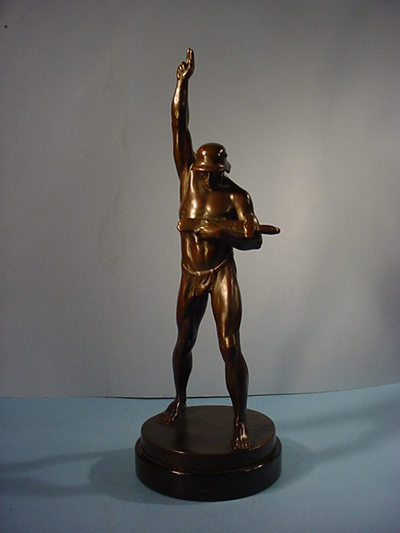 |
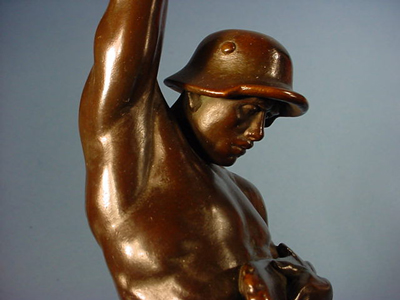 |
Commemorative Bronze Statue Signifying Defiance and Loyalty (Item FREI 1-8, WWI 11-1 & ART 15-11) |
||
| DESCRIPTION: This is a bronze statue that is nothing sort of magnificent both in beauty and deep meaning. It is the classic Roman or Grecian artistic portrayal of the naked warrior who pledges in the traditional manner of a scared oath his faithfulness to his German Fatherland even in its total defeat. He gives the two fingered oath while cradling in his other arm the broken sword with some Latin words that are indistinguishable. He wears only the Stahlhelm (steel helmet). He obviously is representative of the heroes who fought for “Heilege Deutschland” and even more so he is the symbol of fidelity and defiance.
The Bolsheviks and other Red criminals who tried to take over Germany after the end of WWI.
In essence this could be called a Free Corps piece (Freikorps). The soldiers who joined together to put down the Communist revolutionary forces in the 1920’s and early 30’s most of these men after this heroic struggle that had succeeded, then joined the SA (Storm Abteilung”) and marched under the swastika for 12 years, many of them swelling the ranks of Hitler’s Wehrmacht. They were the stuff of “heroic saga.” Had they not joined together to do battle at this point in time, surely the Reds would have been completely successful in their bid to take over Germany and this would have been the major stepping stone to their conquest of all of Europe and who besides God would know what would be their next victory although it is not remembered by most people today We have these brave and valiant men for saving us from a fate worse than death but it also encompassed death “most foul” for millions of Christians who would have seen the inside of the gulags never to emerge again.
The statue is in fine smooth bronze and stands 17 inches high including the plinth and marble base. The plinth has a legend across its front quarter, “Treuschwur” Figur Vom Kreigerdenkmal in Artern A. Kyffhauser Von Juckoff-Skopav. The word “Treuschwor”is the important one and this means, “oath of Loyalty”. This is one of the most dramatic pieces of 1920’s statuary that we have ever seen and it is in perfect condition. It has deep meaning to the historian who is by further definition a “Germanophile”. Very rare indeed but reasonably priced. PRICE: SOLD |
||
WERWOLF
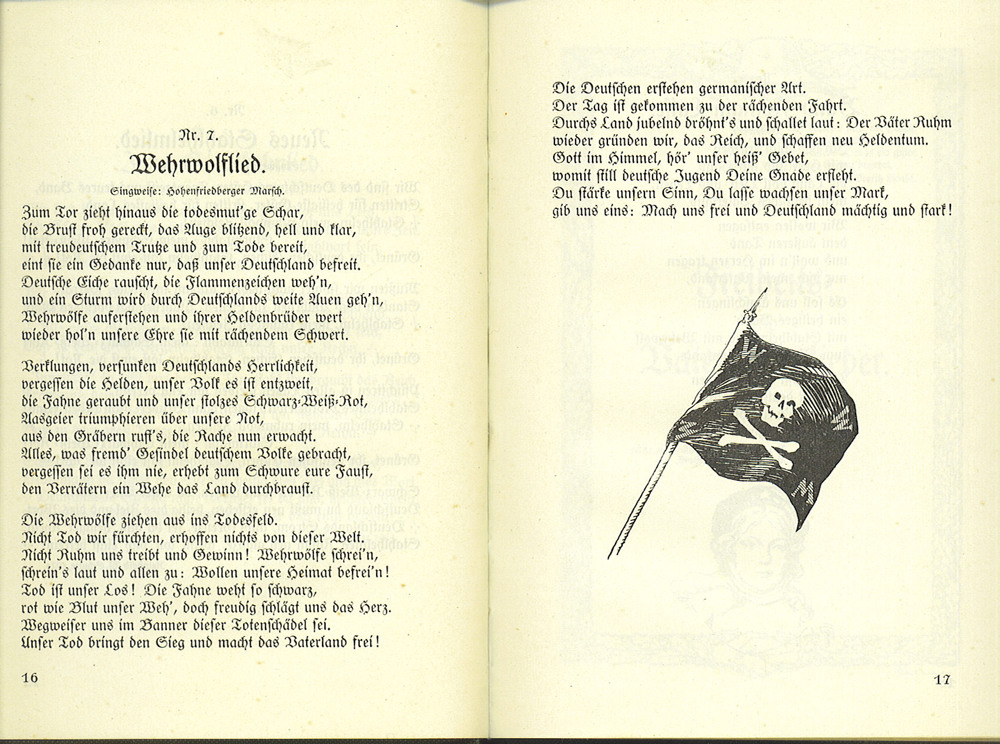
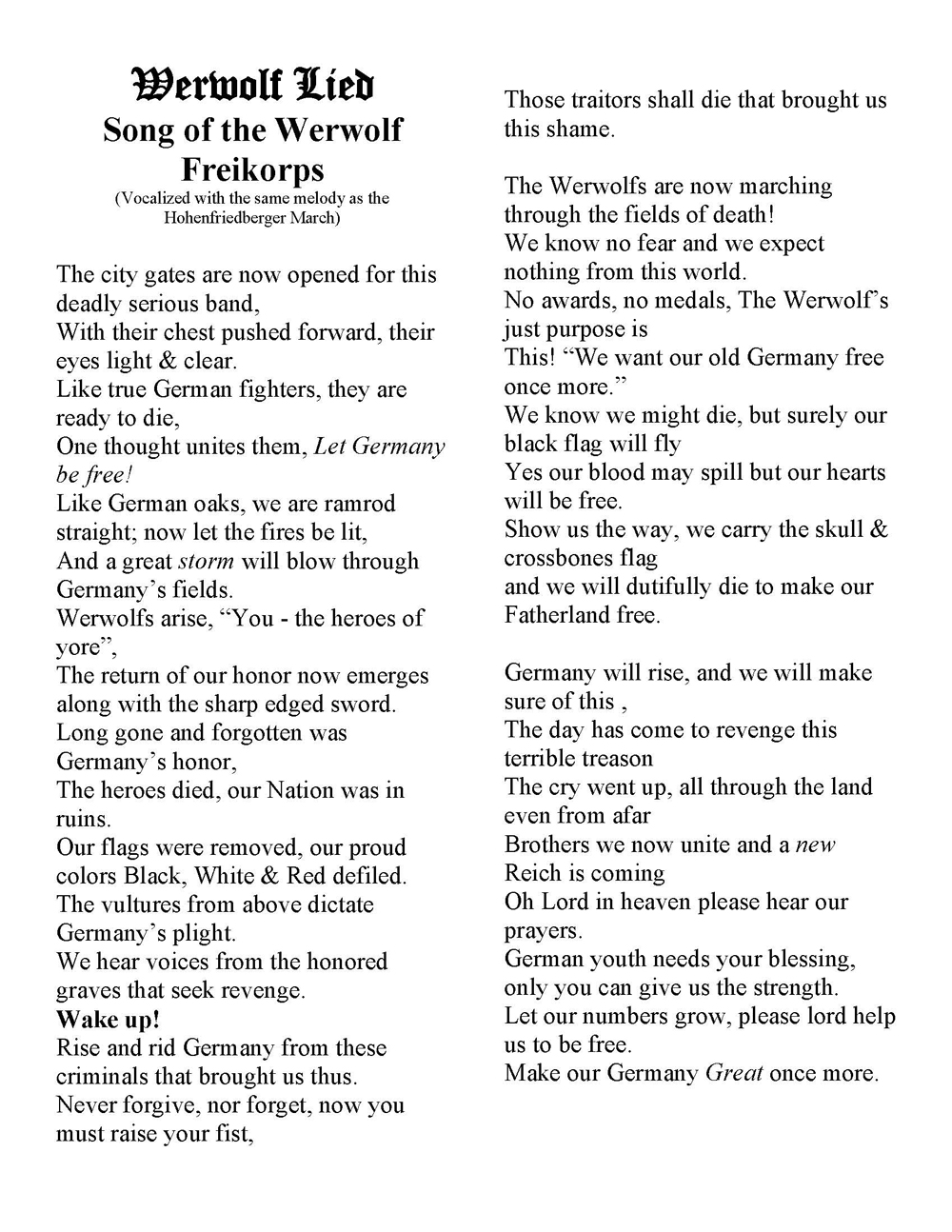
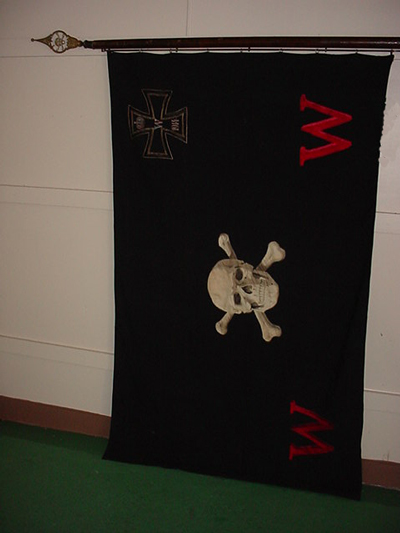 |
 This marvelous picture was sent to us from the photo archives of Mr.Robin Here we have, in all probability, the one and only example of the actual flag
|
The Ultimate Freikorps Flag “The Werwolf Ensign” (Item FREI 1-10 & FLAG 1-8) |
DESCRIPTION: This, in our estimation, is the most rare, exotic, historically important Germanic flag ever to be found. We are also convinced that this is a unique one of a kind item! The Werwolf (in English "werewolf") were a small elite group of tough Freikorp fighters who were a part of the Heydebreck Freikorps. Hans Otto Von Heydebreck, who was called Peter Von Heydebrecht, born 30 June 1889, was a German Freikorps leader, and later a member of the Reichstag and a dedicated National Socialist. During the Red Revolution of November 1918, he founded the counter revolutionary Freikorps named after him. During the Third Silesian uprising in 1921, his troops were foremost in the re-conquest of the “low mountain” at the center of the Battle of Annaberg, gaining Von Heydebreck the epithet of “The Hero of the Annaberg.” This action was the great battle against the Poles in Oberschlesien. He wrote a book of his experiences named “We Werwolves.” This to us confirms that Werwolf was indeed part of Freikorps Heyderbreck. Information has come to us that this separate branch was officially founded in Halle in 1923 in much the same way that the SA formed the nucleus of the SS. The Werwolf emerged as the elite of the Freikorps. Some say that the Wehrbund Der Frontsoldaten was renamed the Werwolf. Background on the name is as follows: Werwolf is a term equivalent to the English werewolf. This would describe man into wolf or “Lycanthrope.” In a novel by that title written by Hermann Loens, there is a romanticized tale of Germanic partisans “Werewolves” in Northern Germany in the 1600’s. In the Hitler youth organization, the term Werwolf comes up repeatedly because it implies mystic properties in combative furor against Germanys enemies. It is historically noted that there was an attempt at the end of the war to call for all-out partisan anti-Allies and anti-“Volksverator” actions. Unfortunately, it never got anywhere. The German people were exhausted but had they any knowledge of what the Allies had in store for them and their leaders, things would have been quite different. The actions of the Werwolf Freikops in the 1920’s and early 30’s did however succeed in instilling justified fear in the hearts of their foes. Many corpses were dumped into landfills as the Werwolves plied their trade! I once had an old man who was a former Freikorp member of the Oberland Unit who worked as a carpenter for me. He said that it got so wearisome shooting those Reds and Spartacus revolutionists all day long up against the wall that his trigger finger got sore and his arm got tired from pulling the bolt handle repeatedly referring to the many hours spent as they executed these Communist terrorists. “Good work if you can get it!” The symbol of the Werwolf was the big red ‘W’ and the leering skull along with the Iron Cross. That along with a swastika was worn by so many of these tough fighters. Due to the combat experience of WWI they had absolutely no compunction about the effective dispatching of Germany’s enemies. It is of little wonder that the loyal HJ members, under the leadership of Obergruppenfuhrer Adolf Pruzmann, chose the name Werwolf for their clandestine guerrilla movement at the end of the Second World War. The flag grouping includes the flag itself, the original pole that comes apart for storage, the finial or flag pole top, the leather carry strap used by the flag bearer when assigned to carry the proud flag of the "Verband" and incredibly 15 plaques that commemorate every parade and ceremonial exercise that the unit took part in. All of those plaques are permanently affixed to a half tubular brass fixture that attaches to the flag pole. It is attached to the bottom-most portion so that it shows up when the flag is set into a stand for display. These plaques are also very rare and collectable; bringing high prices at German military shows. Some are silver and some brass; each has the names of the various units that Werwolf marched with, many of them supplied Freikorp fighters in the past to Werwolf. Many of the plaques are wonderfully artistically good - some featuring iron crosses, an eagle helmet, etc. Again nothing from the early noble struggles has ever shown up that could compare in importance to this flag! We cannot stress how prodigiously important this ensign truly is. Robert G. L. Waite wrote a book named “Vanguard of Nazism - The Free Corps Movement in Post War Germany 1918-1923." The author keenly illustrated the pertinent facts that point out that not only did many of the Freikorps fighters go directly into the National Socialist party in several functions but the very essence of what the Freebooters were doing became the agenda of the anti-Communist Nazis. The spirit of the Freikorps, especially that of the Werwolves, pervaded the early NSDAP and SA factions. The Skull, as seen on our Freikorps flag, was carried over to the banners and flags of the SA Totenkopf brigade which was one of the earliest factions of the Strumabteliung. They were the units that even before the SS leibgarde were responsible for keeping order at NSDAP meetings and even breaking a few communist heads when the need arose. Notice in our attached picture this elite unit on the march. (This picture comes from Das Buch der NSDAP.) Truly, it was the Spirit of the “Werwolf” and its black flag and skull that eventually passed on to the Schultzstaffel - The (SS). When in 1923, the Werwolf had disbanded as an actual combat unit engaged in battle, it became the veterans group named “Werwolf-bund Deutschen Manner und Frontkrieger” (Werewolf Organization of German Men and Front Line Soldiers). As in the days of the Great War and the combat against Poles, bandits, Reds and Sparticists, this group still represented patriotism, honor, and ferocity against Germany’s foes even though most of them now wore the brown shirts of the SA. We can imagine no flag that can be more historically important than this one. It reminds us of Marshal Blucher’s flag that he raised at Waterloo when he proclaimed “Raise high the Black Flag my children - I will kill the first man who shows pity!” PRICE: SOLD |
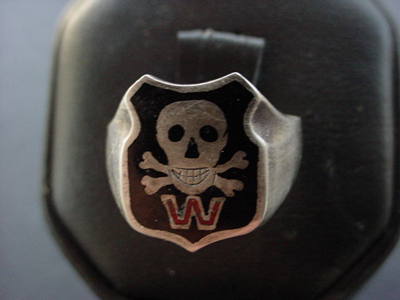 |
Freikorp Werwolf Ring (Item FREI 1-11) |
DESCRIPTION: Here is the ring that would be worn by the veterans of the elite Free Corps Werwolf. For more information about this organziation and the men who were in it, see the narrative about the Werwolf flag just above on this page. Read our narrative on the home page entitled “About our rings and silver insignia.” This will inform you about our big purchase. The ring bears the skull insignia of Werwolf and the W for the group's logo. Iit has 835 as the silver content stamped inside the shank. It is a beautifully proportioned piece of jewelry and can be worn without stirring up too much controversy among the liberals and Baptists. But you personally will know that you wear that symbol that struck absolute and resounding fear in the black hearts of the Reds, Spartacus, and other undesirable street terrorists some 70 years ago. Actually we need them now! This is one of the most important pieces of jewelry of that turbulent era. You may not want to wear it but to keep it safely preserved as the historical treasure it is. PRICE: SOLD |
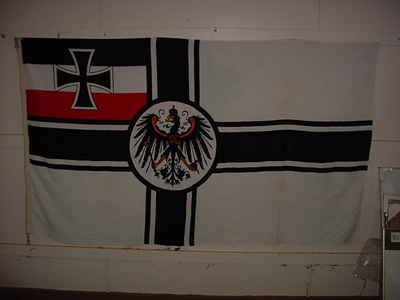 |
ReichsKreigsfahne ( Imperial War Flag) (Item FREI 1-12 & FLAG 3-12) |
DESCRIPTION: This is the flag that fluttered over many a battlefield of WW1. It was the war flag that was flown by both the German Army and Navy although it was seen on ships of the Kaisereich fleet mostly. It is a beautiful ensign with its Iron Cross and the Imperial Hohenzollern eagle that signifies the armed forces of the German Kaiser. The example we offer here is stone mint. We believe it is an example made in the late 20’s or 30’s and used by the Freikorps or the Kreigerbund or Kyfhauser bund (Veterans Organizaitons). It possibly hung in a meeting hall or was used in the parades of these groups. The quality is very good but it does not have the rope running through the bunting edge that would be used in a fold that would attach to a flagpole. We don’t think it was meant to fly. It is large (80 x 47) and it is marked on the edge bunting with the German size 200 x 120. A very dramatic looking banner and it was meant to be. Here is a chance to obtain this beautiful Kreigsfahne and pay much less than an actual flag that would look like this would cost. PRICE: SOLD |
|
|||||||||
|
Beautiful Little Freikorps Song Booklet Entitled Ich hab mich ergeben mit Herz und mit Hand (I have sacrificed with Heart and Hand!; Subtitle: Oberlandliederbuch (Item FREI 1-13; PARTYSONGBOOK 1-4) |
|||||||||
| DESCRIPTION: This was an official booklet handed out to members of the famed Overland (Mountain) Free Corps. These ex-soldiers of WWI were formed in April 1919, and these tough warriors saw bloody action in Munich against the Communist Red brigades and against the Poles in Upper Silesia. It was one of the units that captured Annaberg and they nobly battled in the Ruhr in April 1920. It has often been said that if the Freikorps did not form that the Communists would have surly prevailed and Germany and all of Europe would have sunk into the abominable morass of Soviet tyranny and the horrid reign of terror would have become reality. (Would that there be another Freikorps today? It is needed even more now than then!) The Booklet The little book measures 4 x 6 inches and coNSFreikorpsSongbook2-mprises 32 pages. The cover is just great with an illustration of the armored hand of Götz von Berlichingen, the Knight of the Iron Hand, reaching out to touch the shield with the mountain flower (edelweiss). The shield has the German national colors—black, white, and red. Inside the booklet are such nationalistic songs as: “O Deutschland hoch in Ehren” (“O Germany, High in Honor”); “Die Wacht am Rhein” (“Watch on the Rhein”); “Wenn Alle Untreve Werden” (“When All Were not True”) and many more stirring songs of pride and freedom. It’s just a little book, but its theme and its history are indubitably significant. This was a relic of a struggle that saved Western culture and possibly the very existence of the Teutonic race. PRICE: $125.00; Reduced Special |
|
|||||||||
|
Very Unusual Freikorps Finger Ring (Crossbones and Snakes) (Item FREI 1-14) |
|||||||||
| DESCRIPTION: This is one of the only rings like this I have seen that was made in the era of the valiant Freikorps fighters. I believe it inspired the ring of the Partisan Liquidators of WWII. It has a skull with wide-open eyes sitting on crossbones and surrounded on both sides with coiled snakes. These Freikorps (Free Corps) units were the loyal soldiers who came home from WWI and immediately took up arms against the communist cutthroats that sought to bring the horrid Soviet terror system to Germany. The ring is in “835” silver and has a manufacturer’s logo inside. The ring is a very small size and we have only one. The size is about 6¾ and is in perfect condition. We have similar cutthroats in our nation today: Elizabeth Warren, Chuckey Rabbi Schumer, Sweetie Pie Graham, and Mad McCain. America awaken!
PRICE: $450.00 |
|
|
Commemorative Porcelain Medallion (Item FREI 1-15; NSD 22-2; SA 15-4) |
|
DESCRIPTION: This medallion is dedicated to the memory of Albert Leo Schlageter, the martyred hero who defended his sacred Fatherland and his Deutsches Volk. He was a member of the German Freikorps, and his activities sabotaging French occupying troops after World War I led to his arrest and eventual execution (murder) by the occupying French forces. His way of death fostered an aura of martyrdom around him, which was cultivated by German patriotic nationalist groups, in particular the National Socialist Party. During the Third Reich, he was widely commemorated as a national hero and a genuine Teutonic warrior who died for what to him was a glorious cause. The medallion is of the type and style of the various Meissen porcelain commemoratives. Under the Schlageter cross on the reverse side are the dates “26 Mai 1923” and “26 Mai 1933.” On the obverse side there is a depiction of a bust portrait of the hero and under this (translated) it says: “He fell slain by France’s order on 26 May 1923,” and below his name it has a little box that has the message that translates to: “For peace and freedom for the Ruhr and the Rhine.” The size is about 3 1/2 inches in diameter and it is in perfect condition. This is a true historic treasure honoring a young hero and martyr who refused to renounce his faith in his just cause in the name and spirit of his German fatherland. Please go here to view another award for Schlageter at Item FREI 1-1.
PRICE: $275.00 |
Please refer to item designator in parentheses in all correspondence. Please E-mail for any additional information you may need.If you prefer, contact 'Germania' at PO Box 68, Lakemont, GA 30552 or call at 706.782.1668 or 706.782.4398. Please! do not call during the wee hours of the morning. The best time for calling us is between 9 and 11 am and between 9 and 11 pm eastern time. |


